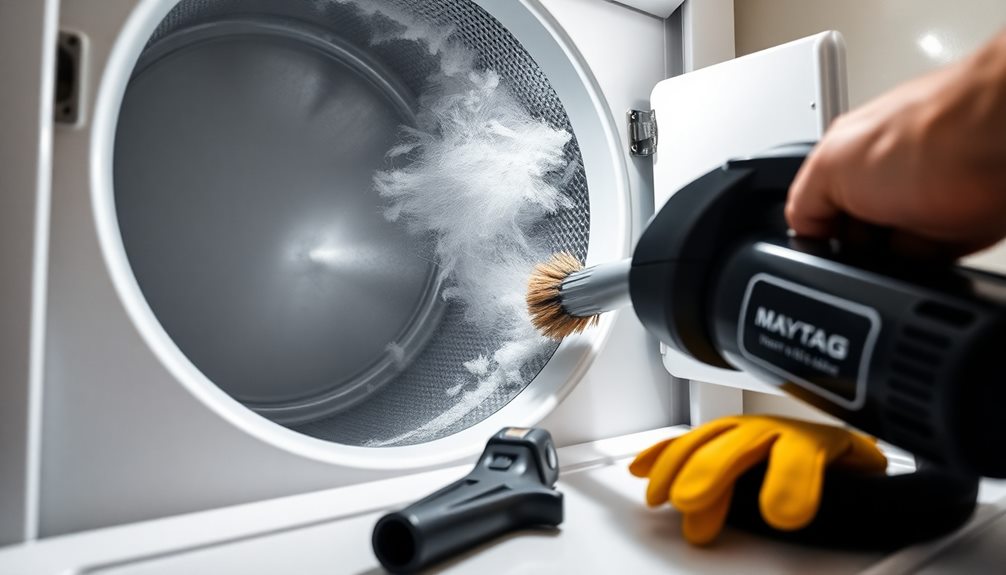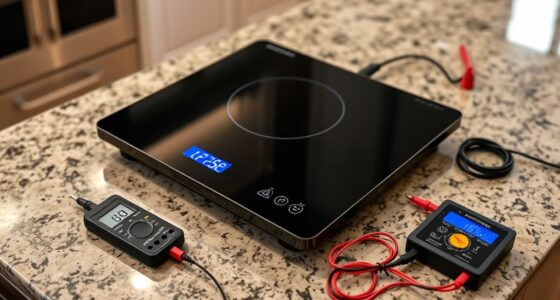An inverter microwave delivers a steady, continuous flow of power through advanced electronic circuitry, unlike traditional models that cycle the magnetron on and off. This technology uses components like IGBTs to control energy precisely, resulting in more even heating and better control over cooking processes. If you want to learn how this technology improves cooking performance and efficiency, keep exploring the differences and benefits of inverter microwaves.
Key Takeaways
- Uses an electronic inverter circuit to convert AC to high-frequency AC for continuous power delivery.
- Provides a steady, adjustable power output instead of cycling on and off like traditional magnetrons.
- Employs advanced semiconductor components, such as IGBTs, for precise and consistent energy control.
- Enables even heating and better temperature regulation, reducing hot spots and overcooking.
- Improves energy efficiency and shortens cooking times through continuous power operation.
How Traditional Microwaves Operate

Traditional microwaves heat food by generating microwave radiation through a component called a magnetron. When you turn on the microwave, electricity flows into the magnetron, creating high-frequency electromagnetic waves. These waves penetrate your food and cause water, fat, and sugar molecules to vibrate rapidly. This vibration produces heat, which then warms your food from the inside out. The magnetron operates at a constant power level, so the microwave cycles on and off to manage the heat intensity. You’ll notice this as a series of pulses or uneven heating, especially with thicker or denser foods. This method is simple and effective but can sometimes result in hot spots or uneven cooking, which is why some microwaves have turntables to help distribute the heat more evenly. Power control in inverter microwaves allows for more precise regulation of energy, leading to more even cooking and better food quality. Additionally, inverter technology enables the microwave to maintain a steady energy output, reducing the likelihood of hot spots.
The Technology Behind Inverter Microwaves

Inverter microwaves utilize a different approach to power delivery by using an electronic circuit called an inverter to control the magnetron’s energy output. Unlike traditional models that switch the power on and off in cycles, inverters provide a steady, continuous flow of energy. This technology converts the incoming AC power into high-frequency AC, which the inverter modulates to produce a consistent power level. The inverter’s precise control allows the magnetron to operate at varying power levels without abrupt changes, resulting in more even heating. This process involves advanced semiconductor components, typically IGBTs (Insulated Gate Bipolar Transistors), which rapidly switch and regulate power. As a result, inverter microwaves deliver smoother cooking, better texture, and improved energy efficiency compared to conventional models. Additionally, the material choices in inverter microwaves contribute to their aesthetic appeal and durability.
Benefits of Inverter Technology in Cooking

Using inverter technology in your microwave offers significant benefits by providing more precise and consistent power during cooking. This means your food heats evenly, preventing cold spots or overcooked edges. You can simmer, defrost, or gently warm without sudden power fluctuations, giving you better control over your cooking. Additionally, inverter microwaves save energy because they operate only as much as needed. They also extend the lifespan of your appliance by reducing stress on components. To better understand these benefits, consider this table:
| Benefit | Explanation |
|---|---|
| Even Heating | Eliminates uneven hot spots |
| Precise Power Control | Better for delicate tasks like melting |
| Energy Efficiency | Uses power only when necessary |
| Reduced Cooking Time | Cooks food faster without sacrificing quality |
| Longer Appliance Lifespan | Less wear on internal components |
Furthermore, inverter technology enhances the microwave’s ability to perform precise temperature control, which is crucial for complex cooking tasks.
Comparing Inverter and Conventional Microwave Performance

When comparing microwave performance, the differences between inverter and conventional models become clear in how they deliver power during cooking. Conventional microwaves cycle their power on and off, which can lead to uneven heating and hot spots. They operate at full power or none, making it hard to cook delicate dishes evenly. In contrast, inverter microwaves provide a steady, continuous flow of power, resulting in more uniform heating. This consistent power delivery helps prevent overcooking edges while keeping the center warm. As a result, inverter models excel at thawing, simmering, and cooking foods evenly. You’ll notice better texture and flavor, especially with sensitive ingredients. Additionally, the tuning options available in inverter models allow for more precise control over cooking settings. Overall, inverter microwaves offer more precise control, ensuring your food heats evenly and efficiently.
Tips for Choosing an Inverter Microwave

Choosing the right inverter microwave involves considering several key factors to guarantee it meets your cooking needs. First, assess the microwave’s wattage; higher wattage means faster cooking. Next, look at the size and capacity to ensure it fits your kitchen space and family size. Consider features like preset cooking modes, sensor cooking, and easy-to-use controls. Durability and brand reputation also matter for long-term performance. Additionally, evaluating energy efficiency can help reduce operational costs over time and contribute to environmental responsibility. This is especially relevant given the growing emphasis on home security and cost savings in household appliances. Incorporating the latest AI discoveries can also lead to innovative features that improve user experience. Moreover, exploring smart features can provide added convenience and connectivity for modern households. Lastly, researching the latest consumer reviews and comparing prices and warranty options can help you get the best value. Here’s a quick overview:
| Factor | Key Consideration |
|---|---|
| Power & Capacity | Match your cooking volume and speed |
| Features | Presets, sensors, control simplicity |
| Durability & Price | Brand reliability, warranty, budget |
Frequently Asked Questions
How Long Does an Inverter Microwave Typically Last?
Inverter microwaves generally last between 7 to 10 years, depending on usage and maintenance. You might find that they tend to be more durable than traditional models because of their advanced technology. To guarantee your microwave’s longevity, keep it clean, avoid overuse, and have it serviced when needed. Proper care helps you maximize its lifespan and get the most value out of your investment.
Are Inverter Microwaves More Energy-Efficient Than Traditional Models?
Inverter microwaves are generally more energy-efficient than traditional models. They use continuous power delivery, so they heat food more evenly and reduce energy waste. When you operate an inverter microwave, you’ll notice it consumes less electricity, especially during longer cooking cycles. This efficiency not only helps save on your energy bills but also extends the appliance’s lifespan, making it a smart choice for eco-conscious households.
Can Inverter Technology Be Used in Other Kitchen Appliances?
You might wonder if inverter technology extends beyond microwaves. Yes, it can. Manufacturers now incorporate inverter systems into appliances like refrigerators, washing machines, and dishwashers to enhance energy efficiency and performance. In these devices, inverter technology allows for precise control of motor speed and power, saving energy and improving functionality. So, you’re likely to find inverter features becoming more common across various kitchen and home appliances.
Do Inverter Microwaves Require Special Maintenance or Repairs?
Inverter microwaves don’t require special maintenance or repairs compared to traditional models. You should keep them clean and ensure vents are unobstructed. If you notice issues like uneven heating or strange noises, it’s best to call a professional. Regularly inspecting the door latch and seal helps prevent problems. With proper care, your inverter microwave will perform efficiently without needing extra maintenance.
Are There Any Safety Concerns Specific to Inverter Microwave Operation?
When using an inverter microwave, you might wonder about safety concerns. The good news is that inverter microwaves operate safely when used properly, just like traditional models. They don’t produce extra radiation or hazards. Just guarantee you follow the manufacturer’s instructions, avoid tampering with internal parts, and keep the appliance in good condition. Proper handling minimizes risks, so enjoy safe, efficient cooking with your inverter microwave.
Conclusion
Choosing an inverter microwave is like upgrading to a smoother ride—you’ll enjoy more consistent cooking, energy efficiency, and precise control. It’s a game-changer that transforms your kitchen experience from chaos to harmony. Don’t settle for the jarring pulses of traditional models; embrace the gentle, steady power of inverter technology. Once you make the switch, you’ll wonder how you ever cooked without it—like finally finding the perfect rhythm in your daily routine.








